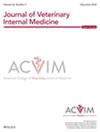The effects of age and sex on reference intervals for cobalamin, homocysteine, and serum and urinary methylmalonic acid in healthy adult dogs
Abstract
Background
In dogs, data on reference intervals (RIs) for cobalamin, markers of metabolism (markersB12met), age and sex effects are limited.
Hypothesis/Objectives
Establish RI for serum cobalamin, homocysteine, and methylmalonic acid (sMMA) concentrations, urinary methylmalonic acid-to-creatinine ratio (uMMA:crea), and determine effects of sex and age.
Methods
Prospective study using healthy dogs (1-10 years). Cobalamin and markersB12met were determined using chemiluminescence immunoassay (cobalamin) and liquid chromatography/tandem mass spectrometry (homocysteine, sMMA, uMMA:crea). In dogs with outlying data, changes in health, markersB12met, and onset of gastrointestinal signs were reevaluated after 9-15 months.
Results
Twelve of 120 healthy dogs had abnormal uMMA:crea ratios. No other cobalamin analyte outliers were found. Outlying data re-examination (odRE) was performed in 10/12 dogs. Chronic gastrointestinal signs occurred in 64% of odRE-dogs, whereas 36% remained healthy. In total, 112 dogs (67 females, 45 males; median ages, 3.5 and 3.75 years, respectively) were included in RI analyses. Reference intervals were 178.5-851 pmol/L (cobalamin), 5.8-29.0 μmol/L (homocysteine), 45.3-159.5 μg/L (sMMA), and ≤22.4 mg/g (uMMA:crea). Only age affected cobalamin concentrations (significant decrease). Compared by sex and neuter status, intact male dogs had significantly higher uMMA:crea ratios (median, 13.5; range, 1.9-83.6 mg/g) than the other groups (median, 2.5; range, 0.7-9.7 mg/g; P < .0001). Sex-specific RI were ≤58.9 mg/g (intact male) vs ≤5.2 mg/g (females and neutered males).
Conclusion and Clinical Importance
Intact male dogs had significantly higher uMMA:crea ratios than the other groups. Thus, sex-specific RI are recommended for uMMA:crea. Because of the wide distribution of uMMA:crea ratios, careful interpretation in intact male dogs is advised.


 求助内容:
求助内容: 应助结果提醒方式:
应助结果提醒方式:


